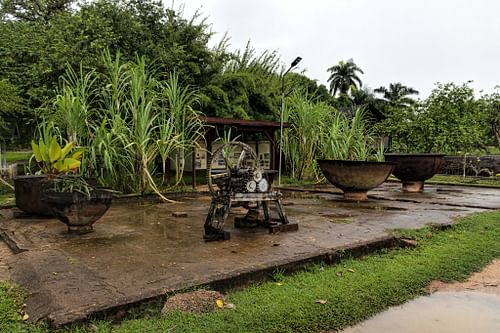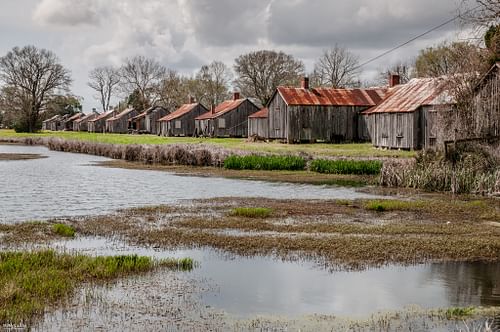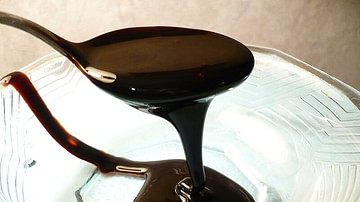From a humble beginning as a sweet treat grown in gardens, sugar cane cultivation became an economic powerhouse, and the growing demand for sugar stimulated the colonization of the New World by European powers, brought slavery to the forefront, and fostered brutal revolutions and wars.

The geographic center of sugar cane cultivation shifted gradually across the world over a span of 3,000 years from India to Persia, along the Mediterranean to the islands near the coast of Africa and then the Americas, before shifting back across the globe to Indonesia. A whole new kind of agriculture was invented to produce sugar – the so-called Plantation System. In it, colonists planted large acreages of single crops which could be shipped long distances and sold at a profit in Europe. To maximize the productivity and profitability of these plantations, slaves or indentured servants were imported to maintain and harvest the labor-intensive crops. Sugar cane was the first to be grown in this system, but many others followed including coffee, cotton, cocoa, tobacco, tea, rubber, and most recently oil palm.
Beginnings of Sugar Cultivation
There is no archeological record of when and where humans first began growing sugar cane as a crop, but it most likely occurred about 10,000 years ago in what is now New Guinea. The species domesticated was Saccharum robustum found in dense stands along rivers. The people in New Guinea were among the most inventive agriculturalists the world has known. They domesticated a broad range of local plant species including not only sugar cane but also taro, bananas, yam, and breadfruit.
The cultivation of sugar cane moved steadily eastward across the Pacific, spreading to the adjacent Solomon Islands, the New Hebrides, New Caledonia, and ultimately to Polynesia. Cultivation of sugar cane also moved westward into continental Asia, Indonesia, the Philippines, and then Northern India. During this advancement, S. officinarum ("nobel canes") hybridized with a local wild species called S. spontaneum to produce a hybrid, S. sinense ("thin canes"). These hybrids were less sweet and not as robust as pure S. officinarum but were hardier and could be grown much more successfully in subtropical mainlands.
Sugar cane was for eons just chewed as a sweet treat, and it was not until about 3,000 years ago that people in India first began squeezing the canes and producing sugar (Gopal, 1964). For a long time, the Indian people kept the whole process of sugar-making a closely guarded secret, resulting in rich profits through trade across the subcontinent. This all changed when Darius I (r. 522-486 BCE), ruler of the Persian Achaemenid Empire, invaded India in 510 BCE. The victors took the technology back to Persia and began producing their own sugar. By the 11th century CE, sugar constituted a significant portion of the trade between the East and Europe. Sugar manufacturing continued in Persia for nearly a thousand years, under a revolving set of rulers, until the Mongol invasions of the 13th century destroyed the industry.
The Muslim Legacy: Mediterranean Sugar Industry
When the Prophet Muhammad began his Holy War to convert the world to Islam in 632 CE, his followers simultaneously started an agricultural revolution. It began in their early Persian invasions when they discovered not only sugar cane but also a long list of crops largely unknown to the rest of the world including artichokes, bananas, coconut palms, cotton, eggplants, lemons, limes, mangos, rice, spinach, sorghum, sour oranges, watermelons, wheat, and yam. In what has been called the Arab Agricultural Revolution, as Muslim armies conquered new regions, they introduced this assemblage of crops and in so doing dramatically altered the agriculture of the whole Mediterranean region.
Sugar cane or "the Persian Reed" was introduced by the Muslims into Egypt in 710, where it became the most sought out source of sugar in the world, reaching its peak production from about 1000 to 1350. From Egypt, sugar cane was spread westward by the Arabs across Northern Africa reaching Morocco and Spain in the middle of the 7th century. Significant sugar production began in Morocco in the late 800s, reaching its peak from 1000 to 1200. Iberian Peninsula production of sugar began about 900, with its boom starting in 1300 and lasting until 1500. These areas remained under Muslim control throughout this period.
The Arabs also introduced sugar to Cyprus, Crete, and Sicily by the early 800s, but significant sugar production did not begin on these islands until well after the Arabs had lost control of most of them. Peak production in Cyprus was from 1300 to 1500, when the island was dominated by the Genoese merchants. The boom years in Crete were from 1400 to 1500 under Venetian rule. In Sicily, the golden years of production were from 800 to 1050 when the island was still under Muslim control and then again from 1380 to 1520 when it was essentially under Spanish rule.
Expansion of Sugar Production by the Portuguese & Spanish
The Portuguese ultimately took control of worldwide sugar production in the 15th century as an economic by-product of their exploration and colonization of the Atlantic Islands along the African coast. The first plantations were set up after the Portuguese colonization of Madeira when Prince Henry decided that sugar production held the key to success for his Atlantic acquisitions, and he sent to Sicily for cane plants and experienced sugar technicians. Armed with this knowledge the first sugar plantations were established by clearcutting land to establish large farms and building factories to process the sugar. The first sugar was refined in Madeira in 1432, and by 1460 the island was the world’s largest sugar producer. Sugar was the main product of the island until the mid-16th century when it was gradually replaced by wine.
In the 15th century, the Portuguese also discovered and developed the unpopulated Azores, Cape Verde Islands, and São Tomé, while the Spaniards conquered the already inhabited Canary Islands. Sugar never became important in the Azores and Cape Verde Islands, but the Spanish Canaries and Portuguese São Tomé became major sugar producers by the late 1400s. From the very beginning of Atlantic sugar production, slave labor was the main source of manpower. The Spanish started out by forcing the native peoples the Guanches to work in the cane fields. When there were too few Guanches left alive from disease and overwork to take care of their fields, they imported African slaves.
Brazil
In the 16th century, the center of sugar production began to shift to the Spanish-controlled Caribbean, first in Santo Domingo, and then to a smaller extent in Cuba and Puerto Rico. Christopher Columbus (l. 1451-1506) had introduced sugar cane to the region on his second voyage of 1493. The Spanish were still much more interested in finding gold and silver, but they found the profit of sugar too enticing to pass up. They imported skilled sugar masters from the Canaries in 1515 and sent their first shipment of sugar to Europe soon after.
The Portuguese discovered Brazil in 1500, and it did not take them long to begin planting sugar cane there. The first sugar plantation was established in 1518, and by the late 1500s, Brazil had become the leading supplier of sugar to the European markets. Brazilian sugar production reached its peak in the 1620s in the Pernambuco and Bahia regions, at about 15,000-20,000 tons a year.
When the Portuguese arrived in Brazil in the early 1500s, they quickly set about subjugating the local Tupi to work in their mines and harvest their sugar cane. However, the Tupi proved to be poorly adapted to the routine, sedentary lifestyle of farming and were particularly uncooperative slaves. They were also very subject to western diseases and found it relatively easy to run away and hide in the dense forest. The Portuguese solution to this labor problem was to turn to the African slave trade, a system they had already employed in their Atlantic sugar plantations off the coast of Africa. By the mid-16th century, African slavery predominated on the sugar plantations of Brazil, although the enslavement of the indigenous people continued well into the 17th century.

The burgeoning sugar industry of the Portuguese was first largely financed by Dutch merchants, but the Dutch eventually established their own colony in northeastern Brazil. There they were active sugar producers from 1630 to 1654, until they were expelled by the Portuguese. The Dutch took their money, expertise, and shipping to the Caribbean, which was now being actively colonized by the British and French. Within 30 years, the Caribbean took over dominance of worldwide sugar production, driving the price of Brazilian sugar down by two-thirds and severely reducing their exports.
Caribbean Sugar Industry
The Brazilian sugar industry found its competition, first from the tiny island of Barbados, and ultimately from a hodgepodge of British-, French-, and Dutch-controlled islands. Originally settled in 1627, Barbados became one massive sugar factory by the 1640s, dominated by a handful of large plantation owners. Plantation life and labor were hard and fast, with lives being shortened by rampant disease and booze, but the hardiest (and lucky) amassed vast sums of wealth and lived opulent lifestyles patterned after that of the British Royalty.
By the late 1600s, sugar production was important on a number of Caribbean Islands including the British-controlled Antigua and Nevis, French-controlled Martinique, Guadeloupe and St. Dominique (now Haiti), and French- and British-controlled sections of St. Kitts. Dutch merchants had amassed great wealth ferreting goods to and from the islands. Ultimately, British Jamaica became the crown jewel of Caribbean sugar production, after a long and difficult settlement period.

Sugar Politics
The most productive years of sugar production in the Caribbean coincided with a tumultuous period of European politics, when France, England, Spain, and the Netherlands were continually at war in various combinations. All the European conflicts spilled over into the Caribbean, and the importance of the Caribbean sugar plantations to the European economy had far-ranging effects on North America. By the 1700s, sugar was the most important internationally traded commodity and was responsible for a third of the whole European economy. The English Islands also produced considerable quantities of rum consumed by British drinkers all across the world, while the French shipped vast quantities of molasses to the British American colonies, where it was made into rum and sold throughout the continent.
When the British northern colonies declared their independence in 1776, the subsequent war was really fought by the British on two fronts, North America and the Caribbean. The Caribbean sugar industry was simply too valuable to be ignored and it was a much more important component of the British economy than the northern colonies. Britain had no choice but to maintain a strong force in the Caribbean during the Revolutionary War. It is likely that this attention aided the northern colonists greatly in winning their independence.
Slave Rebellion in St. Dominque
By the 18th century, the center of sugar production had moved to St. Dominque, the French half of Hispaniola. Thousands of sugar plantations now dotted its landscape and it had become the richest sugar island. This dominance would literally go up in flames at the end of the century when the slaves successfully rebelled and established a free nation. This freedom was won by defeating the armies of Europe’s leading powers, first France and then Great Britain. A man named Toussaint became the de facto ruler of St. Dominique, calling himself “L’Ouverture” ("the opening"). On 1 January 1804, St. Dominque was declared independent and became Haiti, the second nation in the Americas (after the United States) to free itself from European control. Fittingly, Haiti was the original indigenous Arawak’s name for Hispaniola.
The Founding Fathers of the United States wrested mightily over the concept of Haiti. There was widespread fear that a similar rebellion could occur in the southern US among the hundreds of thousands of slaves held in captivity. The recognition of Haiti stood in limbo in the US for over 60 years, waiting until President Abraham Lincoln acknowledged it in 1862 during the Civil War, just before his landmark Emancipation Proclamation.
After the Haitian revolution, many sugar planters fled to Cuba and Louisiana. Cuba soon became the world center of sugar production, while Louisiana became the sugar bowl of the US. The whole plantation system of the Caribbean was essentially transferred to Cuba and Louisiana, where slavery still existed.
When the Civil War began and cut off sugar supplies from Louisiana to the North, Hawaii became the new sugar production center for the US. Sugar cane had actually arrived in Hawaii in prehistoric times and was being grown there by the indigenous people long before Cook’s discovery of the islands, but modern plantations were not established until the mid-1800s.
Numerous other sugar centers cropped up across the globe in the mid to late 19th century including British and Dutch Guiana (Guyana), East Africa, Mauritius, Natal (South Africa), and Queensland (Australia). Slavery had been abolished across most of the world by then, and these sugar plantations all came to depend on indentured workers, mostly from India. Over one million Indian indentured workers went to sugar plantations from 1835 to 1917, 450,000 to Mauritius, 150, 000 to East Africa and Natal, and 450,000 to South America and the Caribbean.
Dutch Sugar Production in Java
In the mid-1800s, the Dutch built a huge sugar industry in Java by exploiting the native people. The Javanese were required to grow cane for them, deliver it to factories, and then work in those factories. At the heart of what was called the “Cultivation System” were 94 water-powered Dutch sugar factories, which processed raw cane into refined sugar. In the 1850s, the Dutch collected detailed information on over 10,000 villages and came up with a plan where catchment areas were identified with a radius of approximately 4-7 kilometers around each factory. All villages within these catchment areas were then reorganized to grow cane.
Over the course of the system, millions of Javanese worked in sugar processing and transport - via both forced and free labor. By one estimate, a quarter of the population was involved in the industry. The system became so massive, that in the mid-19th century, sugar production in Java accounted for one-third of the Dutch government’s revenues and 4 percent of Dutch GDP. Java came to be one of the world’s most financially lucrative colonies.
In 1870, an Agrarian Law was passed in the Netherlands that abolished forced labor and allowed private companies to lease land in sparsely populated areas. This led to widespread investment in larger plantations and a great expansion into western Java and Sumatra. Sugar was joined by coffee, tea, and tobacco. The early plantations were begun by private investors, but over time were replaced by international corporations. The labor pool shifted from forced family units to indentured servants, mostly illiterate peasants from Java and Singapore.
Emergence of the Sugar Beet & Today’s Sugar Industry
During the Napoleonic Wars (1803-1815), cane sugar was no longer available in French-controlled Europe due to the naval blockade of the British. To satisfy the French sweet tooth, the humble beet, already a source of food and fodder in Europe, came to be grown and processed for its sugar. The amount of sugar in the beets was then much lower than sugar cane, and the extraction process was costlier, but it was pretty much the only source of sugar available. Napoleon ordered the planting of thousands of acres of sugar beets, and by 1814 more than 300 factories were making sugar from beets. When Napoleon’s empire collapsed after Waterloo, the boycott was lifted, and the cheaper Caribbean cane sugar took back its European dominance.

Sugar production from beets remained in the twilight for several decades, until the British banned slavery in the Caribbean, causing cane sugar prices to rise substantially. By now, beets had been selected with sugar levels that were comparable to sugar cane and the cost of extraction had dropped dramatically. Now the two kinds of sugar were almost on equal footing. By 1854, 11% of the world’s sugar came from beets and by 1899 65% more sugar was extracted from sugar beets than sugar cane.
Today, Brazil is once again the leading sugar producer in the world, followed by India, the EU, China, Thailand, and then the USA. Brazil, India, and Thailand grow almost exclusively sugar cane, while the EU is predominantly sugar beet, the US is about 50%, and China is 20% sugar beet. Most of the labor force in today’s cane fields are still workers brought in from outside the production regions by labor managers. These workers continue to serve as cheap labor almost as slaves when money for food, housing, and other necessities is deducted from their salary leaving them in debt.
Learn more about daily life on sugar plantations in our article Life on a Colonial Sugar Plantation.









